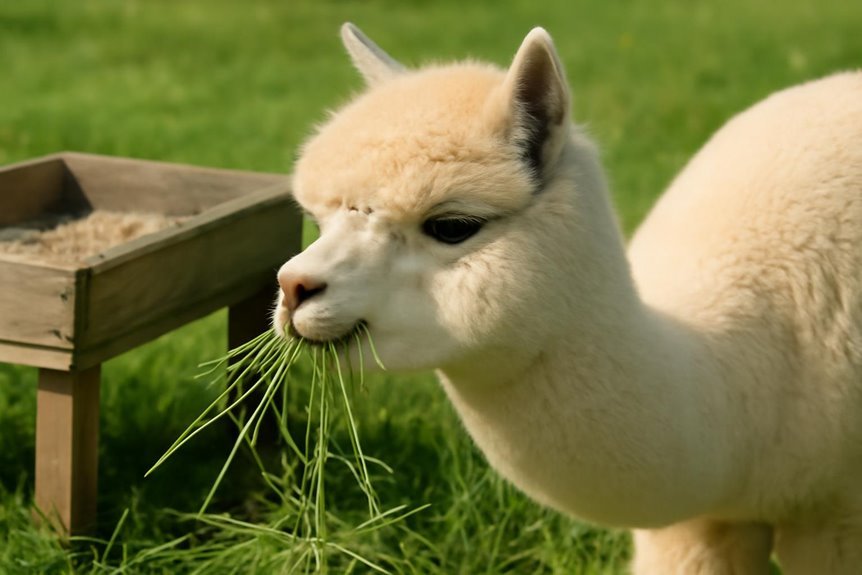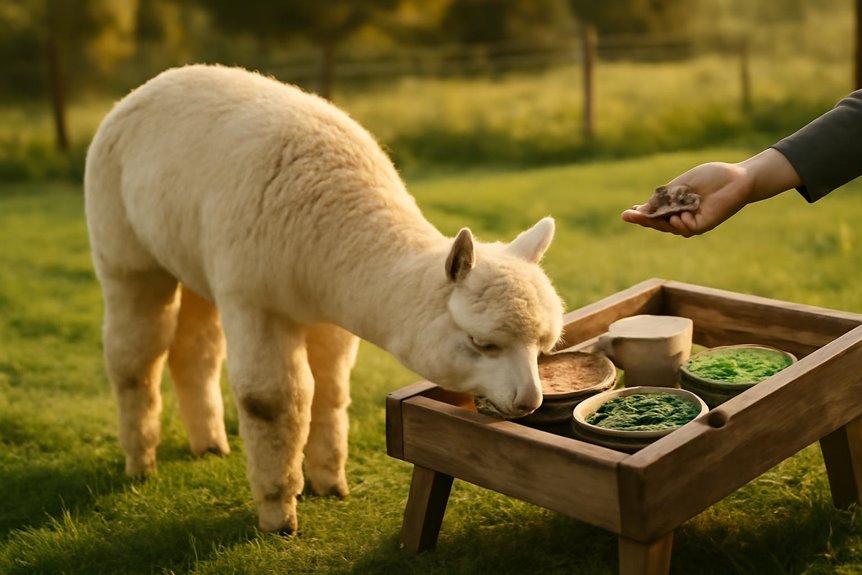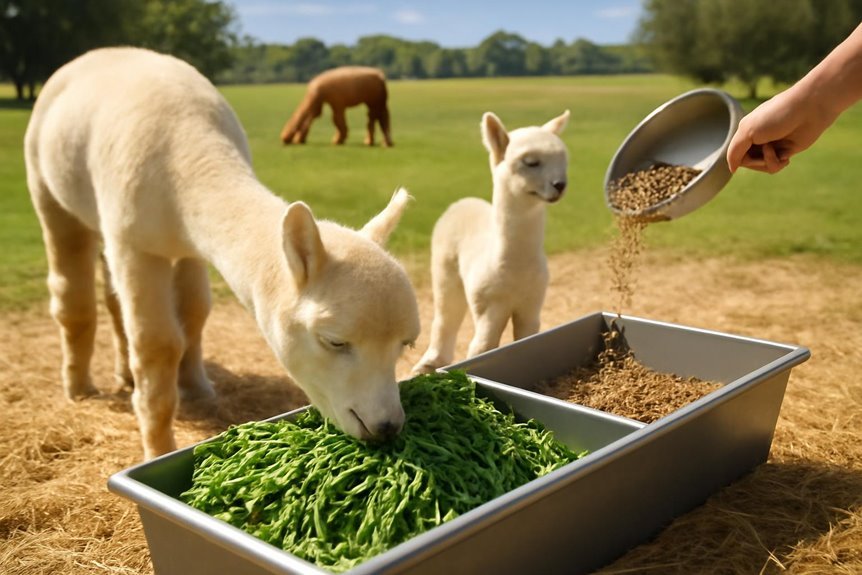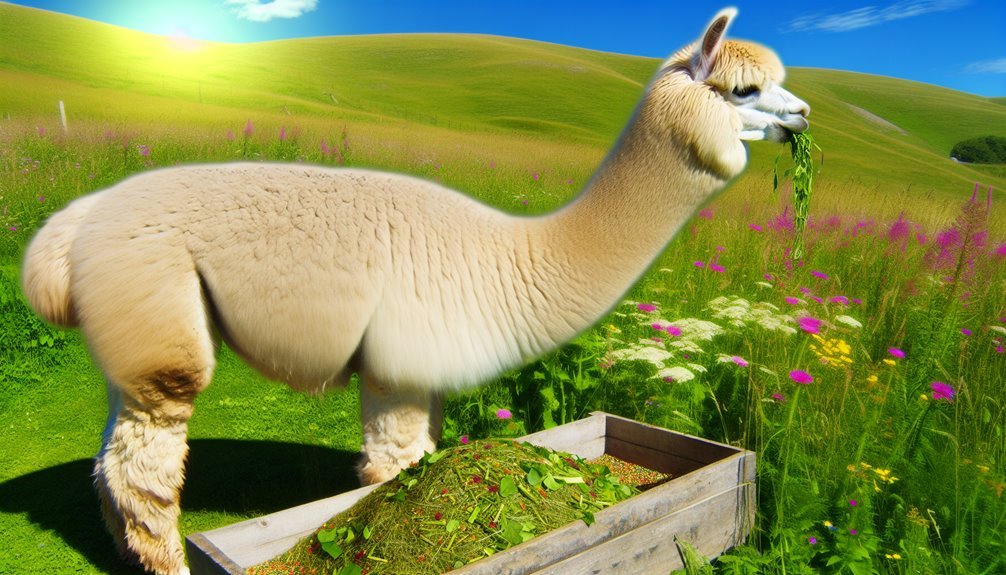How to Feed Alpacas for Optimal Fiber Quality
To feed your alpacas for the best fiber quality, focus on high-fiber, soft forage like orchard grass, timothy, and alfalfa, ensuring it’s fresh and nutrient-rich. Use concentrates sparingly, tailored especially during late pregnancy or lactation, and provide a loose alpaca-specific mineral mix to avoid toxicity. Always supply clean water, as hydration affects fiber softness and health. Adjust feeds for age and life stage to keep fleece fine and strong. Learn how these strategies optimize your alpacas’ fiber production.
Key Takeaways
- Provide high-quality, soft forage like orchard grass, timothy, and alfalfa to support fiber fineness and staple length.
- Maintain a consistent diet with long fiber grass hay available at all times to promote healthy digestion and fiber growth.
- Use alpaca-specific loose mineral mixes to prevent toxicity and support overall fiber quality.
- Adjust feed protein levels carefully; moderate protein supports growth, while excessive protein can coarsen fleece.
- Ensure constant access to clean, fresh water to maintain hydration and enhance fiber appearance and health.
Understanding Alpaca Nutritional Needs

When you’re feeding alpacas, it’s important to understand their nutritional needs to keep them healthy and thriving. Providing quality feed rich in essential nutrients supports both alpaca health and the development of high-quality fleece. Their diet should mainly consist of high-fiber forage such as orchard grass, timothy, and alfalfa, which promotes proper digestive health. You’ll want to offer daily feed equating to about 2% of their body weight, ensuring long fiber grass hay is always available. Concentrates should be used sparingly, tailored to specific needs like late-gestation or lactating females to avoid digestive upset. Don’t forget a loose, alpaca-specific mineral mix to prevent toxicity, and always supply clean, fresh water to keep hydration ideal and digestion functioning smoothly.
Importance of High-Quality Forage
Providing your alpacas with high-quality forage makes a significant difference in their health and fleece quality. High-quality forage supplies essential fiber that supports digestion and overall alpaca health, directly influencing the fiber they produce. You’ll notice that forage like alfalfa, which is lower in fiber and more digestible, offers better nutrient absorption than mature grasses. This improved nutrient intake enhances fiber softness and strength. Keep in mind, the maturity stage of forage affects its fiber content and digestibility—harvesting too late increases lignin, reducing quality. Regularly testing your forage helps guarantee your alpacas get the nutrients they need, and if quality slips, you can adjust their diet accordingly. Prioritizing high-quality forage is key to maintaining your alpacas’ health and ideal fiber development.
Role of Hay and Pasture in Fiber Development
You’ll want to focus on selecting the right pasture mix and high-quality hay to support your alpacas’ fiber growth. The type of forage they consume directly affects fiber characteristics like staple length and fineness. Understanding how grazing habits influence these factors will help you optimize their diet for the best fiber development.
Pasture Selection Strategies
Although alpacas can eat a variety of forages, selecting the right mix of pasture and hay is key to developing high-quality fiber. Focus your pasture selection on soft grasses like orchard grass, timothy, and fescue, complemented by legumes such as white clover and alfalfa, which provide higher protein levels essential for an alpacas diet. Soft grasses encourage grazing, improving nutrient intake critical for fiber growth. Keep in mind that while higher protein is beneficial, excessive levels can lead to coarser fleece. Regular testing of pasture nutrient levels helps you adjust feed to meet your alpacas’ needs precisely. By carefully managing pasture quality and composition, you’ll support ideal fiber development and maintain the health and productivity of your alpacas.
Hay Quality Importance
Quality hay plays a crucial role in maintaining your alpacas’ health and producing fine fleece. High-fiber diets based on good hay quality guarantee alpaca health and quality fiber production. Since alpacas are selective eaters, providing waste-resistant feeders helps minimize hay waste and assures consistent nutrition. Forage quality, especially younger, less mature plants, offers better digestibility and nutrients essential for fiber development. Poor-quality hay can lead to coarser, less desirable fleece, while top-quality hay promotes softer, finer fiber. Regularly testing your hay and pasture lets you spot nutrient gaps and adjust feeding to support ideal alpaca health and quality. Prioritizing hay quality is key to enhancing your alpacas’ fiber and overall well-being through balanced, nutrient-rich forages.
Grazing Impact on Fiber
Beyond hay, the pasture your alpacas graze on plays a significant role in shaping their fiber. As an alpaca owner, you should prioritize pasture management to guarantee your animals have access to soft grasses and legumes like orchard grass, timothy, fescue, white clover, and alfalfa. These plants boost fiber quality by providing essential nutritional content. Remember, alpacas selectively feed and may discard low-quality hay, so supplementing with high-quality hay is vital. Proper pasture care and soil health assessments improve forage quality, directly affecting fleece characteristics such as micron diameter and luster. To optimize fiber development, focus on:
- Maintaining diverse, nutrient-rich pasture mixes
- Providing consistent access to high-quality hay
- Conducting regular pasture management and soil checks
Selecting Appropriate Concentrates and Supplements

When choosing concentrates and supplements for your alpacas, you’ll want to focus on clean, mold-free ingredients that meet their unique nutritional needs. Selecting concentrates should be done carefully, as Nutrition is fundamental to avoid digestive issues like acid buildup. Late-gestation females require about 1% of their body weight in concentrates, while lactating females and growing alpacas need around 2%. Providing a loose mineral mix formulated specifically for alpacas is crucial, as minerals meant for other species may cause copper toxicity. High-quality nutrition supports not only overall health but also enhances Alpaca Fleece Quality. Nutrient-dense concentrates, combined with quality forage, help optimize fiber production. Regularly evaluating the balance of supplements guarantees your alpacas receive the essential nutrients needed for vibrant, strong fleece.
Providing Essential Minerals for Health and Fiber
Along with selecting the right concentrates and supplements, ensuring your alpacas get the proper minerals plays a big role in keeping them healthy and maintaining strong, vibrant fiber. As an alpaca farmer, providing a high-quality mineral mix tailored for alpacas is essential. Deficiencies can hurt fleece production and overall health, especially during gestation and lactation when nutritional demands rise. Avoid copper-containing mixes made for other species since copper is toxic to alpacas. Instead, choose llama-specific or no-copper sheep mineral products like those from Stillwater Minerals. Keep monitoring mineral intake based on your environment to meet your herd’s unique needs.
- Use a high-quality mineral mix formulated for alpacas
- Prioritize mineral supplementation during gestation and lactation
- Avoid copper-containing mineral mixes to protect fleece quality
Hydration and Its Impact on Fiber Quality
Since water makes up a significant part of your alpacas’ daily needs, ensuring they stay properly hydrated is vital for maintaining healthy fiber. Alpacas typically drink 5-8% of their body weight in water daily, but in hot weather or lactation, this can rise to 10-18%. Providing constant access to clean water supports hydration, which is essential for digestive health and efficient nutrient absorption. When hydration falters, nutrient uptake suffers, negatively affecting overall health and leading to poor fiber quality. Dehydration can dull fleece appearance and reduce fiber strength. To promote ideal fiber quality, regularly check and clean water sources, making sure your alpacas always have fresh, uncontaminated water. Prioritizing hydration directly supports their health and the luxurious fiber you aim to produce.
Tailoring Feeding Programs by Life Stage

Although all alpacas need balanced nutrition, tailoring their feeding programs to specific life stages guarantees they get exactly what their bodies require. By adjusting diets, you support their health and quality fiber production effectively. For instance, gestating and lactating females require nutrient-dense, higher energy feeds to sustain themselves and their crias. Growing alpacas and non-fiber adults do well on multipurpose feeds with moderate protein, while premium feeds are key for fleece-producing and show animals, especially during late pregnancy. Senior alpacas benefit from energy-rich diets to maintain weight and health.
Tailoring alpaca diets by life stage ensures optimal health and quality fiber production.
Key feeding considerations by life stage include:
- Providing premium feeds during the final 120 days of pregnancy for ideal fiber quality
- Offering nutrient-dense rations for gestating and lactating females
- Adjusting energy levels for growth, maintenance, and senior care
Frequently Asked Questions
What Is the Best Way to Feed Alpacas?
Back in the day, knights knew balance was key—just like you should with feeding schedules, nutrient balance, and forage types. Don’t forget water intake and vitamin supplements to keep your alpacas thriving and healthy every day.
How Do You Care for Alpaca Fiber?
You’ll want to follow fiber maintenance techniques like gentle washing alpaca fleece, use proper shearing best practices, store fleece in cool, dry conditions, and apply suitable fiber processing methods to keep your alpaca’s fiber in top shape.
What Is the Best Alpaca Fiber?
Imagine velvet spun by nature’s hand—that’s the best alpaca fiber. You’ll want fiber characteristics like fine micron count and luster, which excel in fiber grading, fiber processing, and fiber markets, all while ensuring fiber sustainability.
How to Grade Alpaca Fiber?
You’ll use fiber grading techniques focusing on micron count importance and fleece evaluation criteria like staple length and crimp. Quality assessment methods include color classification systems to guarantee uniformity, helping you accurately grade alpaca fiber for premium textiles.








Our picks
Alpaca & Wool Felted Sole Inserts: Comfy Upgrade?
Best Alpaca Socks for Hiking: Ultimate Comfort and Durability on Trails
Best Alpaca Halter for Comfort and Control